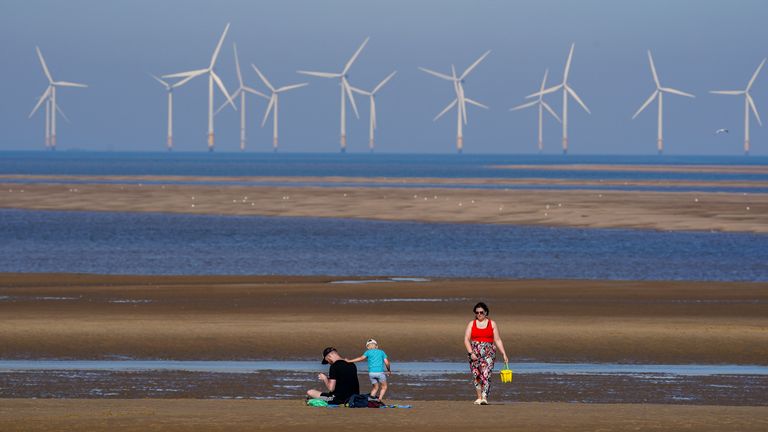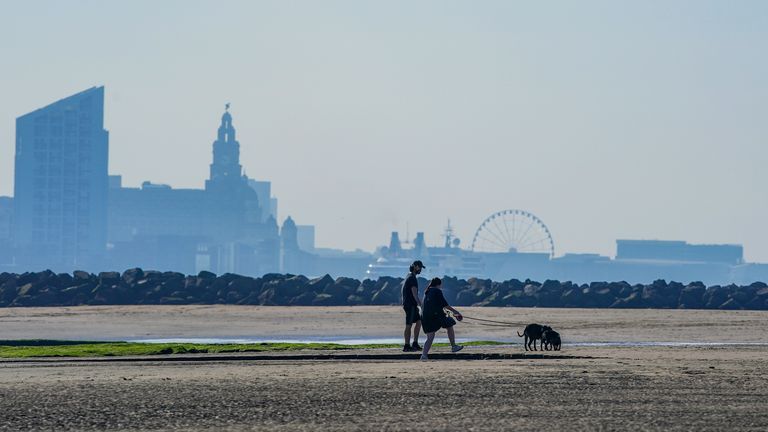The UK is having a late summer burst of hot weather – while parts of the Mediterranean have been experiencing a phenomenon known as a “heat dome”, forecasters say.
Temperatures in Britain could soar as high as 32C (90F) this week, as much as 4C (39F) higher than Ibiza.
Here, Sky News looks at what is causing the unusually warm conditions in the UK and elsewhere in Europe – and whether we are set for an official heatwave.
What is a heat dome?
A heat dome is loosely defined as an area of high pressure that stays over the same area for days, or even weeks.
Hot air is trapped underneath like a lid on a saucepan, pushing temperatures above what’s normal for the time of year.
The heated air expands upwards into the atmosphere, then high pressure from above acts as a lid, meaning it can’t escape and causes the air to subside or sink – creating a dome effect, the Royal Meteorological Society said.
As the warm air sinks, it compresses and heats up, which then traps more heat underneath and clouds are pushed around it, keeping the heat in even more.
Find out the weather forecast for your area
The Met Office says heat domes encourage temperatures “to keep building day on day”.
However, Sky weather Meteorologist Dr Chris England said the phenomenon “doesn’t really apply to the current heat of the UK”.
He said that while a heat dome “has been relevant to some of the Mediterranean heat”, the high pressure affecting the UK “is well to the east”.
“Instead, the flow around the high pressure is generally from the south over the UK, bringing heat up from the Mediterranean and north Africa,” Dr England added.
The Met Office says tropical storms in the far western Atlantic, and deep areas of low pressure, have helped to amplify the jet stream over the Atlantic Ocean and has led to high pressure “dominating over the UK”.
Is the UK set for an official heatwave?
The word “heatwave“ is often used to describe any period of sunny weather, but the Met Office defines it as “an extended period of hot weather relative to the expected conditions of the area at that time of year”.
It says the UK experiences a heatwave when it has at least three consecutive days with daily maximum temperatures meeting or exceeding the heatwave temperature threshold – and this threshold varies by UK county.
Sky weather forecaster Kirsty McCabe said official heatwave conditions “will be met this week as temperatures soar over the next few days with a late blast of summer heat, especially for southern parts of the UK.”
Read more:
Spain hit by heavy rains
Scout jamboree chaos amid soaring heat
The peak is likely to occur on Wednesday and Thursday with 31C (88F) or even 32C (90F) possible.
The threshold temperature ranges from 25C (77F) in Scotland and Northern Ireland, to 28C (82F) in London and the Home Counties.
But Ms McCabe said “it’s not just hot weather heading our way, a Saharan dust plume will cross the UK, bringing some spectacular sunrises and sunsets”.
Hitting 30C in September “used to happen around once every seven years or less, but has occurred more frequently in the last decade,” she said.
Could we have the hottest day of the year this week?
This year’s highest temperature is 32.2C (90F) at Chertsey on 10 June and Coningsby on 25 June.
Ms McCabe said: “There is a chance we could exceed that this week [Wednesday or Thursday].”
The highest September temperature ever recorded in the UK was 35.6C (96F) in South Yorkshire in 1906.
Is this an Indian summer?
According to the Met Office Meteorological Glossary, an Indian summer is a warm, calm spell of weather that occurs in autumn, “especially in October and November.”
There is, the Met Office says, no statistical evidence to suggest that such warm spells recur at any particular time each year – warm spells during the autumn months are not uncommon.
How long will the UK’s hot weather last?
The UK Health Security Agency has a yellow alert in place across the whole of England, apart from the North East, until 9pm on 10 September.
Temperatures reached 30C on Monday in southern England and the southeast of Wales, according to the Met Office – and the hot weather will continue through Tuesday, with highs of 31C (88F) expected.
Met Office spokesperson Oli Claydon said: “We will see good sunny conditions through the week with cloudless skies, and some high temperatures by the time we get to Wednesday and Thursday, where we could see 31 maybe 32 degrees.”
The Met Office said temperatures could also hit 31C (88F) on Friday, although there could be more cloudy weather and chances of rain in the far northwest of Scotland.
But the weather conditions could change over the weekend and Mr Claydon said there is “no indication at the moment of another strong heatwave after this”.
He added: “Through the weekend, we start to see some heavy, potentially thundery, showers developing but (they are) only isolated. There is a little bit of uncertainty as we start to get that far ahead.”
Average temperatures are expected to return by the middle of next week.




